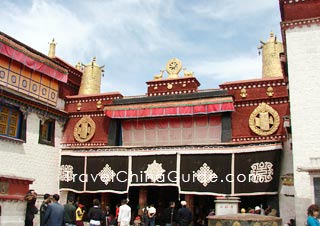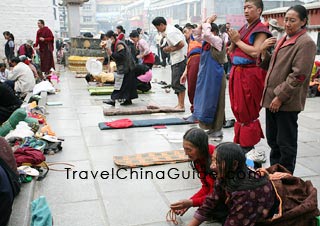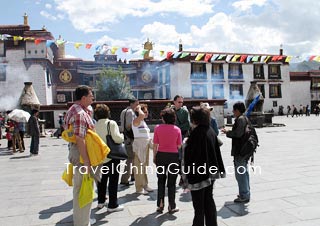Jokhang Temple
Jokhang Temple Facts
Area: 25,100 square meters (about six acres)
Built in: Tang Dynasty (618 - 907)
Construction Style: Tang, Tibet, and Nepal styles
Included on UNESCO's World Heritage list in 2000 as part of the Potala Palace, the Jokhang Temple is the ultimate pilgrimage destination for Tibetan Pilgrims.
History of Jokhang Temple
The Tang Dynasty (618 - 907), was characterized by economic prosperity and great progress in politics. During this time, China was considered the cultural and political center of the world. King Songtsem Gampo (617 – 650, the 33rd king of Tibet) was the leader of the Tubo (or Tibetan) Kingdom. He actively promoted Buddhism in that region and under his reign, Tibet achieved great progress in social innovation and realized the integration for the first time. In order to promote friendly relationships with the neighboring countries, he successively married Princess Bhrikuti of Nepal and Princess Wen Cheng of the Tang Dynasty. When the two wives arrived there, each brought a statue of Jowo Sakyamuni. During this time, most people lived in tents and there were few palaces. To house the Buddha brought by Princess Wen Cheng, King Songtsem Gampo constructed the Little Jokhang. Jealous of her, Princess Burikuti asked Gampo to build a Jokhang for her as well. Therefore, in 647 the giant complex was built.
The original complex included only eight shrines. After multiple renovations, most notably during the Yuan Dynasty (1206 - 1368), the Ming Dynasty (1368 – 1644) and the Qing Dynasty (1644-1911), the complex grew to the scale that exists today.
Legend of Jokhang Temple
Whether the legend is true or not, the Jokhang Temple brought Buddhism into this land and became an inseparable part of Tibetan history and culture. The city of Ra-Sa grew around the temple and over time, become known as Lhasa, a holy land.
|
|
Layout of Jokhang Temple
 |
Standing in its square, one can view the entire complex. On the square there are two steles, one recording an alliance between the king of Tibet and the emperor of the Tang, the other portraying the teaching of the local people to prevent and treat smallpox, a once incurable disease in that region.
In the eastern section of the yard there are rows of votive lights. These flicking lights provide a path leading all the way to the main hall. The main hall, over 1,300 years old, is the oldest shrine of the complex. Above the major entrance, there is a Dharma Wheel (chakra) flanked by two deer. This represents the unity of all things and symbolizes Sakyamuni himself. On both sides of the passageway, paintings showing the building of Jokhang Temple, and renderings from the seventh century are adorned on the wall. The statue of Sakyamuni at age 12 sits in the middle of the hall. It has been gilded many times and decorated elaborately with jewels typical of Tibet. Statues of King Songtsem Gampo, Princess Wen Cheng and Princess Bhrikuti are on the second floor. On the top floor, there are four gilded bronze tile tops crafted in the emblematical Tang style.

Statue of Sakyamuni
How to get to Jokhang Temple
| Entrance Fee | CNY 85 |
|---|---|
| Opening Hours | 7:00 - 17:30, while from 7:00 to 11:30, it's mainly open for pilgrims. |
| Recommended Time for a Visit | 2h |
Other Temples in Lhasa
Ramoche Monastery
Sera Monastery
Zaki Temple (Zhaji Temple) ![]() Further Reading
Further Reading
Top 10 Things to Do in Lhasa



